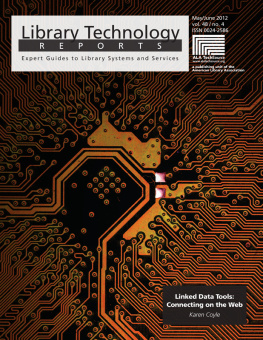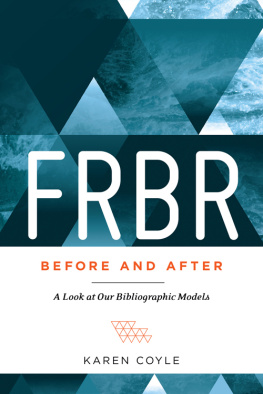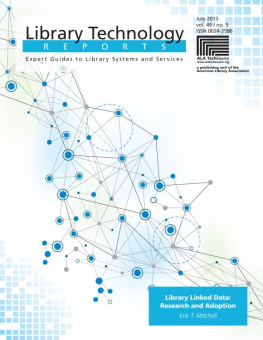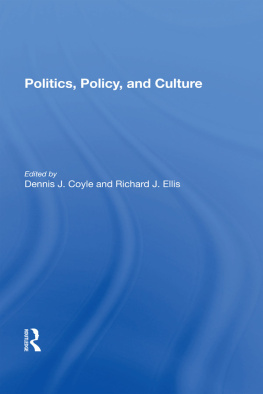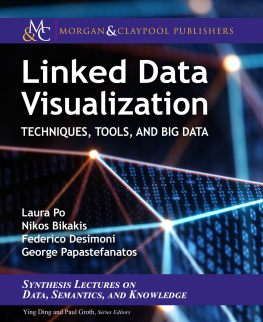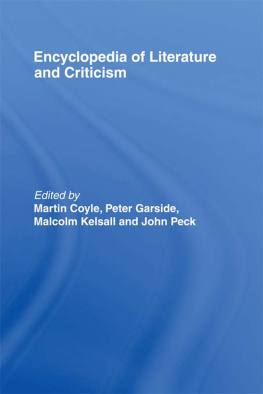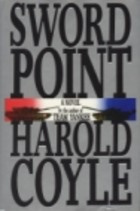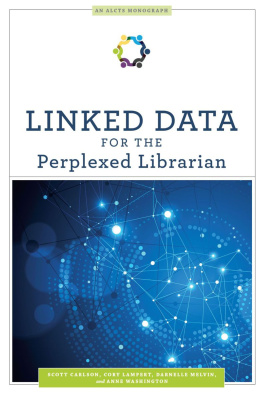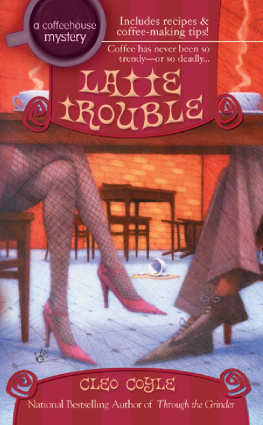Karen Coyle - Linked Data Tools: Connecting on the Web
Here you can read online Karen Coyle - Linked Data Tools: Connecting on the Web full text of the book (entire story) in english for free. Download pdf and epub, get meaning, cover and reviews about this ebook. year: 2012, publisher: American Library Association, genre: Computer. Description of the work, (preface) as well as reviews are available. Best literature library LitArk.com created for fans of good reading and offers a wide selection of genres:
Romance novel
Science fiction
Adventure
Detective
Science
History
Home and family
Prose
Art
Politics
Computer
Non-fiction
Religion
Business
Children
Humor
Choose a favorite category and find really read worthwhile books. Enjoy immersion in the world of imagination, feel the emotions of the characters or learn something new for yourself, make an fascinating discovery.
- Book:Linked Data Tools: Connecting on the Web
- Author:
- Publisher:American Library Association
- Genre:
- Year:2012
- Rating:5 / 5
- Favourites:Add to favourites
- Your mark:
- 100
- 1
- 2
- 3
- 4
- 5
Linked Data Tools: Connecting on the Web: summary, description and annotation
We offer to read an annotation, description, summary or preface (depends on what the author of the book "Linked Data Tools: Connecting on the Web" wrote himself). If you haven't found the necessary information about the book — write in the comments, we will try to find it.
Linked Data Tools: Connecting on the Web — read online for free the complete book (whole text) full work
Below is the text of the book, divided by pages. System saving the place of the last page read, allows you to conveniently read the book "Linked Data Tools: Connecting on the Web" online for free, without having to search again every time where you left off. Put a bookmark, and you can go to the page where you finished reading at any time.
Font size:
Interval:
Bookmark:
Library Technology Reports
Expert Guides to Library Systems and Services
Linked Data Tools: Connecting on the Web
Karen Coyle

alatechsource.org
Library Technology Reports
ALA TechSource purchases fund advocacy, awareness, and accreditation programs for library professionals worldwide.
Volume 48, Number 4
Linked Data Tools: Connecting on the Web
ISBNs: (print) 978-0-8389-5859-9; (PDF) 978-0-8389-9429-0;
(ePub) 978-0-8389-9430-6; (Kindle) 978-0-8389-9432-0.
American Library Association
50 East Huron St.
Chicago, IL 60611-2795 USA
alatechsource.org
800-545-2433, ext. 4299
312-944-6780
312-280-5275 (fax)
Advertising Representative
Patrick Hogan
312-280-3240
Editor
Dan Freeman
312-280-5413
Copy Editor
Judith Lauber
Production and Design
Tim Clifford, Production Editor
Karen Sheets de Gracia, Manager of Design and Composition
Library Technology Reports (ISSN 0024-2586) is published eight times a year (January, March, April, June, July, September, October, and December) by American Library Association, 50 E. Huron St., Chicago, IL 60611. It is managed by ALA TechSource, a unit of the publishing department of ALA. Periodical postage paid at Chicago, Illinois, and at additional mailing offices. POSTMASTER: Send address changes to Library Technology Reports, 50 E. Huron St., Chicago, IL 60611.
Trademarked names appear in the text of this journal. Rather than identify or insert a trademark symbol at the appearance of each name, the authors and the American Library Association state that the names are used for editorial purposes exclusively, to the ultimate benefit of the owners of the trademarks. There is absolutely no intention of infringement on the rights of the trademark owners.

alatechsource.org
2012 Karen Coyle
All Rights Reserved.
About the Author
Karen Coyle is a librarian with over thirty years of experience with library technology. She now consults in a variety of areas relating to digital libraries. Karen has published dozens of articles and reports, most available on her website, kcoyle.net. She has served on standards committees including the MARC standards group (MARBI), NISO committee AX for the OpenURL standard, and was an ALA representative to the e-book standards development that led to the ePub standard. She follows, writes, and speaks on a wide range of policy areas, including intellectual property, privacy, and public access to information. As a consultant she works primarily on metadata development and technology planning. She is currently investigating the possibilities offered by the Semantic Web and linked data technology.
Abstract
This issue of Library Technology Reports presents an overview of current developments in Semantic Web technology that provide the foundations for making library data accessible on the Semantic Web. Author Karen Coyle introduces basic Semantic Web concepts and then describes the metadata activities and developer tools that are being used to create Semantic Web applications. She points readers to projects within and beyond the library community that are a source of metadata elements and controlled vocabularies. For software developers, she describes available software tools in the nascent world of linked data and the Semantic Web.
Contents
 (Everything flows, nothing stands still.)
(Everything flows, nothing stands still.)
Heraclitus
I t doesnt take a great philosopher to know that writing about an emerging technology is like trying to record a river that is flowing past faster than one can put words to paper. Even in the months that can pass during the writing process, significant changes can take place. That knowledge can become an invitation to procrastination or the author can simply accept that no treatise will be entirely complete or up-to-date. My goal, therefore, is not to be exhaustive but to offer a mental model for working with the Semantic Web in the form of linked data. In particular, I wish to show that the foundational resources, in the form of standards, data element sets, and term lists, have been developed to a point that it is possible to see how the parts will fit together. There is also beginning to be enough linked data content to highlight the gaps that need to be filled. I also wish to emphasize that it is the nature of the Web of knowledge that no lists or schemes or collections will ever be considered complete.
Introduction
Abstract
Chapter 1 is the Introduction to this issue of Library Technology Reports. Library activities in recent years, particularly those that have contemplated the future of bibliographic control, have given libraries a theoretical basis for the move from traditional catalogs to the Web as a data platform. Library catalogs have already evolved to federate resources from external locations and to bring in data from remote sources. FRBR, RDA, and the commitment of the Library of Congress to a new bibliographic framework all point libraries in the direction of shared, linked data.
T he world today is clearly not that of our library predecessors, of Dewey and Cutter, not even of Lubetzky or even Gorman. The changes that have taken place since the introduction of the personal computer and the globalization of communication over the World Wide Web are huge, and they affect in particular anyone involved in knowledge research and creation. Lets do a brief environment scan.
Todays world is highly computerized; we have computers on our desks, in our pockets, and even in our pens. It isnt, however, the cold, oppressive, machine-like computerization of 1950s science fiction. The amount of user interaction is astonishing, even ignoring the edge cases of the teenagers who send hundreds of text messages a day or the constant Tweeters. Users expect to have an effect on their virtual world, even if that only means creating their own Facebook page. Facebook is in fact a prime example of user-created content, along with Flickr, YouTube videos, blogs, and Tweets.
The spread of global computing has overthrown some of our previous assumptions about institutions and power. The do-it-yourself information system can be personal and political, as we have seen with efforts like WikiLeaks and with the fact that some bloggers now have the publics ear in a way that was once reserved for network news celebrities.
Todays resources are either becoming digital or already born digital. This is not the end of print, but print is definitely becoming a format of the past. Few college students today would consider print to be a modern technology, although many undoubtedly still find it useful at times. Digital resources are relatively easy to find (through keyword searching) and to obtain (because they are online), but they can be hard to use because they require specific technical skills. They also require devices that add a new cost to the use of information. Users are dependent on software tools that are not controlled by the library and may not work as well as is desired. Access often means obtaining a copy that the user then needs to manage.
Yet todays users expect to work independently without prior instruction; they have come to expect the single search box as their interface.
The entire concept of communication is changing. Communication is increasingly remote and asynchronous, not face-to-face and in real time. There is a rise of new media (especially video) over old (text): increasingly, instruction is provided in video format rather than textual documentation.
Font size:
Interval:
Bookmark:
Similar books «Linked Data Tools: Connecting on the Web»
Look at similar books to Linked Data Tools: Connecting on the Web. We have selected literature similar in name and meaning in the hope of providing readers with more options to find new, interesting, not yet read works.
Discussion, reviews of the book Linked Data Tools: Connecting on the Web and just readers' own opinions. Leave your comments, write what you think about the work, its meaning or the main characters. Specify what exactly you liked and what you didn't like, and why you think so.

